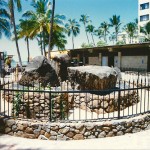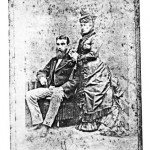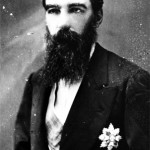Na Pohaku Ola Kapaemahu A Kapuni: Waikiki’s Healing Stones
Millions of years ago, through fissures in the ocean floor, volcanic eruptions promised life to what would become Hawai‘i. Through the darkness and depths, centuries of volcanic rock became islands. Yet, beyond the actual creation of the Hawaiian Island chain, stone is essential within Hawaiian tradition. In the Hawaiian language, the word is pohaku. However, not only does pohaku mean “rock” or “stone,” but it also means “foundation.” Thus, na pohaku is both the very literal foundation of these Islands and a vital part of Hawaiian culture. Healing and birthing stones; stones carved to represent gods; stones for ki‘i pohaku (petroglyphs); stones to create tools; and stones gathered and placed in the construction of heiau (places of worship) all exist here. But central is the idea that, like all living things, stones, too, have mana (spiritual power).
In Waikiki, along Kuhio Beach, four particular stones stand together embracing a collective legacy within Hawaiian history and culture. Oral traditions tell us that, before the reign of O‘ahu’s chief Kakuhihewa, four individuals came from Tahiti to the shores of Waikiki bringing with them tremendous healing powers. Kapaemahu was the leader of the four and honored for his ability to cast aside carnality and care for both men and women. Kapuni was said to envelop his patients with his mana. While Kinohi was the clairvoyant diagnostician, Kahaloa— whose name means “long breath”—was said to be able to breathe life into her patients. The art of healing they practiced is known in the Islands as la‘au lapa‘au. In this practice, plants and animals from the land and sea, which are known to have healing properties, are combined with great wisdom to treat the ailing.
The four healers settled in the area within Waikiki known as Ulukou but soon became renowned throughout all of O‘ahu. When the time drew near for them to return to Tahiti, they wanted their presence and power to remain in a tangible form. They would each place their healing powers, their mana, within four separate stones that could then be used by the Hawaiian people in their absence.
They called for the stones to be brought from a Kaimuki quarry, nearly two miles away. The particular basaltic rock they chose, often referred to as “bell stone,” was selected because of the tonal quality it possessed when struck. It is said that thousands came on Po Kane (the Night of Kane) to move the stones, each one weighing several tons. Originally, two were placed where the healers dwelled and two where they bathed. Ceremonies lasted for one cycle of the moon; then, the four healers were gone.
It was not until the first decade of the 1900s that Gov. Archibald Cleghorn discovered two stones on his property and two on an adjacent property. Recognizing their significance, Cleghorn had them excavated and placed together on his estate with the stipulation that they should not be moved. However, in 1941, the estate land was leased out for the building of a bowling alley. Exemplifying a low point in the recognition of and appreciation for the Hawaiian culture, the stones were actually used in the building’s foundation.
Upon the bowling alley’s demolition in 1958, the stones were identified and repaired. Then, in 1963, they were relocated to Kuhio Beach. However, their historical importance was still not fully understood. Oral traditions were further investigated and the stones’ original significance became clearer. Plus, there had begun a concerted movement in the Islands to reestablish Hawaiian language and culture. So, in 1980, the stones were moved again, approximately 50 feet mauka (toward the mountains) from their 1963 location.
Finally, in 1997, action began to create a permanent and more appropriate home for the stones. The movement was led by kupuna and cultural practitioner Richard Paglinawan under the spiritual guidance of Papa Henry Auwae po‘okela (master) of la‘au lapa‘au for all of Hawai‘i. Cultural historian and great-great-grandson of Archibald Cleghorn, Manu Boyd, recalls, “The value and meaning of the stones had faded over time with the changing values and mores of the day. Then, their importance was remembered and embraced by people who wanted to restore them.” For years, committed individuals collaborated on plans to create a wahi pana (sacred place) where Na Pohaku could be honored and protected.
The entire restoration project was planned around the lunar calendar, and every step, from when to begin the excavation to which way each stone should face, was conducted with the spiritual guidance of Papa Auwae. A paepae (platform) and an ahu (altar) were built to protect and honor the healing stones and elevate their cultural prominence.
In addition to the many involved with the restoration, a delegation from Tahiti was present for the final ceremonies. These individuals blessed the stones with wild basil, traditionally used for cleansing, and presented a small stone from Tahiti named Ta‘ahu ea as a ho‘okupu (offering). That stone is now set on top of the altar in front of Na Pohaku.
It was at this time that the name was changed from “Wizard Stones of Kapaemahu” to “Na Pohaku Ola Kapaemahu a Kapuni,” undoing the westernized understanding of healing powers as some sort of magic. Following the direction of Papa Auwae, four plants with medicinal value were added to the site—ma‘o (Hawaiian cotton), ‘ohe (bamboo), makahala (wild tobacco) and naupaka kahakai (beach naupaka). The group Na Haumana La‘au Lapa‘au O Papa Auwae is the adoptive caretaker of Na Pohaku. Babette Galang, who studied la‘au lapa‘au under Auwae, explains, “We were advised by Papa Auwae before his passing that we were to malama [take care of] the site.” Galang and others wash the stones, tend to the plants and clean the surrounding areas in a manner that follows a very specific protocol as detailed by Auwae.
Over the years, the importance of these stones has been misinterpreted.
They were disrespected and desecrated then recovered and reunited. Their very essence encompasses the connection between Hawai‘i and Tahiti and the depth of healing that can take place through la‘au lapa‘au. In addition, Na Pohaku Ola Kapaemahu a Kapuni stand as a testament to the culture within the Hawaiian Islands in which mana exists in all living things— a more that is truly foundational for the people of Hawai‘i.
- Archibald Cleghorn and Princess Likelike. Photo courtesy of Fields Masonry.
- Archibald Cleghorn was the father of Princess Ka‘iulani. Photo: Hawaii State Archives.
- Gov. Cleghorn Estate, Ainahau. Photo: Hawaii State Archives.













